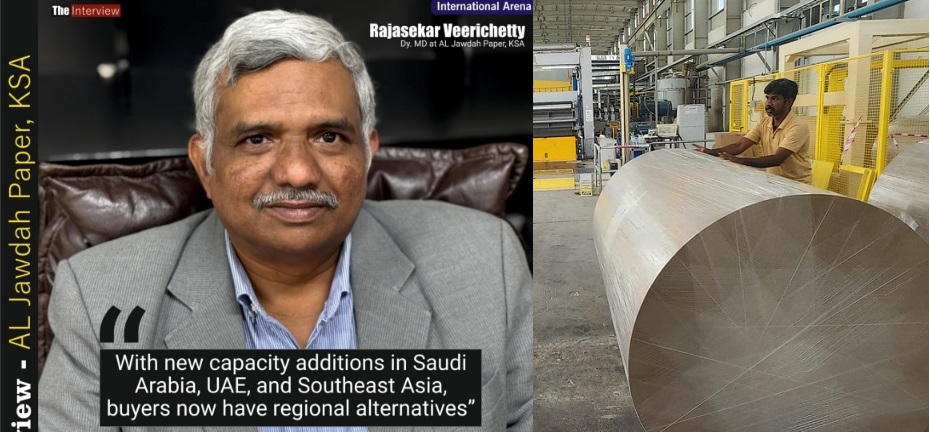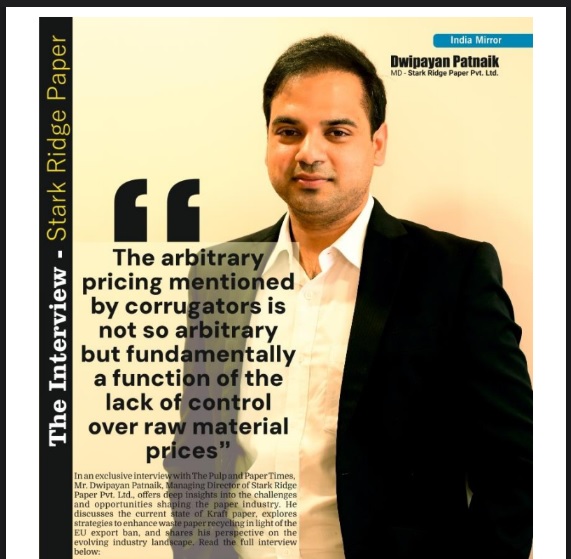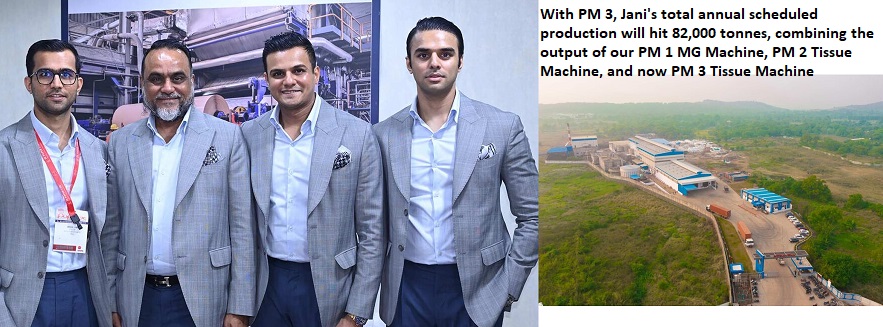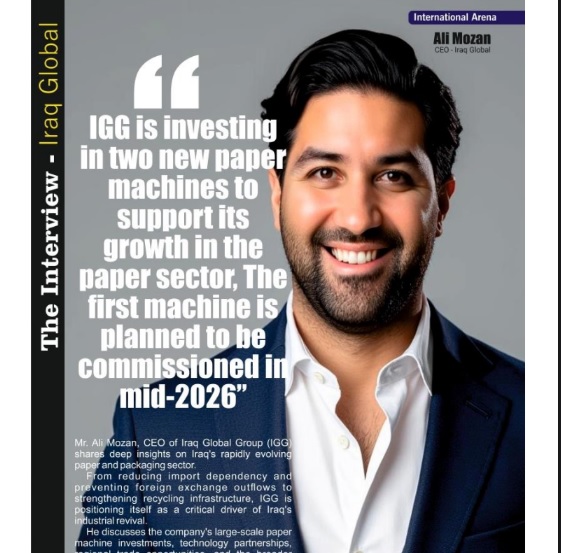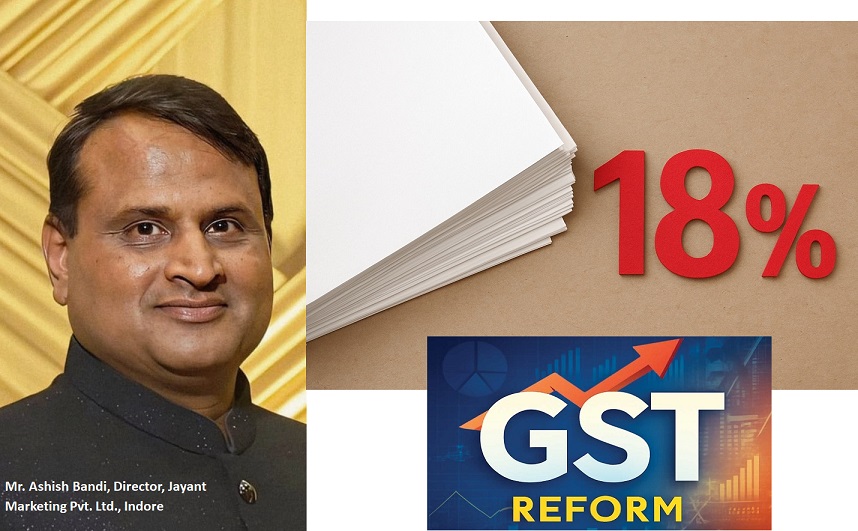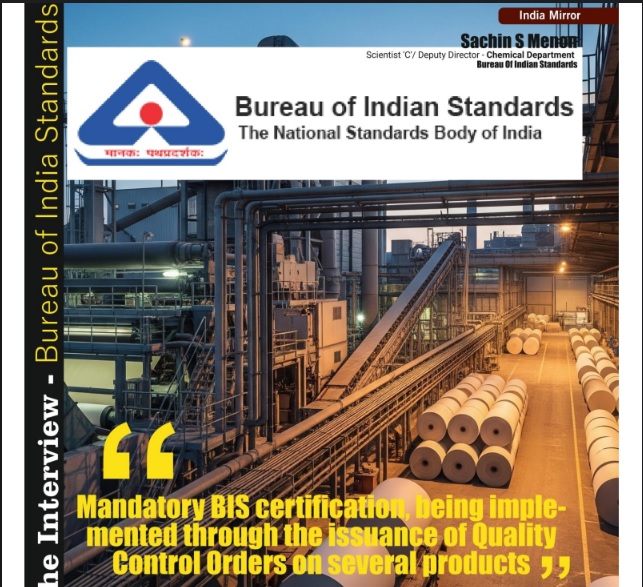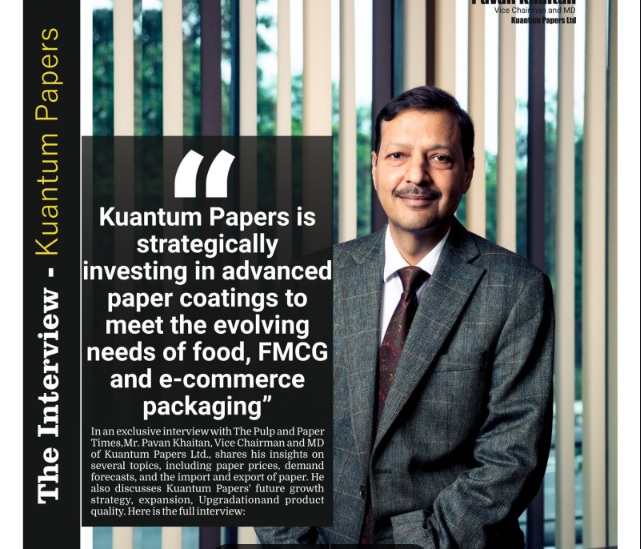"Despite this significant influx of new capacity, we have observed price increases in pulp rather than the anticipated decline," says Mr. Javier Montes of CMPC Pulp
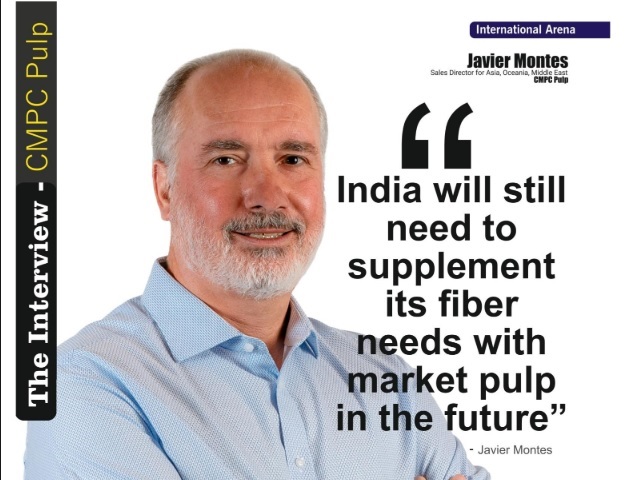
"Despite this significant influx of new capacity, we have observed price increases in pulp rather than the anticipated decline," says Mr. Javier Montes of CMPC Pulp
Key Points:
-India will still need to supplement its fiber needs with market pulp in the future
-There may be other economic factors at play in Asia which will determine the pricing of WPP in the next few months to come
-Trade barriers imposed by the US and EU that is making paper exports from China very difficult
CMPC is an integrated forestry group with more than 100 years of history. CMPC has different business units, produces and markets wood, pulp, packaging products, household and non-household sanitary protection products, and tissue paper. In an exclusive interview, Mr. Javier Montes, Sales Director for Asia, Oceania, and the Middle East at CMPC Pulp, discusses various aspects of the pulp market and its impact on India and the world. Mr. Montes shares his insights on the future of the pulp market, trends in wood prices, and the shifting dynamics of global trade patterns. Here are his views:
The Pulp and Paper Times
Q: Please give us a brief introduction to CMPC
CMPC is an integrated forestry group with more than 100 years of history. It´s based in Chile, with subsidiaries and offices in Latin America, USA, and more recently Europe and China. CMPC has different business units, produces and markets wood, pulp, packaging products, household and non-household sanitary protection products, and tissue paper. Its products not only satisfy the needs of customers, but are renowned for their quality and competitiveness, and for being manufactured from entirely renewable sources.
Its high level of pulp production places the company as one of the largest pulp suppliers in the world, reaching around 4.5 million tons per year. With four mills located in Chile and Brazil, CMPC produces hardwood and softwood pulp, known throughout the world and used as raw material in a range of products from printing and writing paper to paperboards, tissue grades and other specialty products.
CMPC offer is based on leadership in costs, consistent quality products, a logistic service of excellence and raw materials from certified sustainable plantations. We have an absolute commitment to safety, communities and social environment. That´s why CMPC made 4 environmental goals for 2030 (https://www.cmpcpulp.com/Sustainability)
Q: How do you analyze the current market scenario of pulp? The Red Sea crisis and increased freight costs have pushed pulp prices for the Indian subcontinent, thus increasing paper prices at the domestic level. How do you see the next 3 to 6 months for the WPP and pulp segments?
The Red Sea impact was quite sudden and catastrophic for the global supply chain. However, the impact has now reached its peak or maximum level. We do not expect any further aggravation to the situation on account of Red Sea. They may, in fact, only resolve from here and ease the situation.
To the best of our belief, the Indian production capacity depending on market pulp in India is only about 5% of total fiber need (fine paper & packaging paper). The impact of pulp prices on Indian production costs should not be as significant.
There may be other economic factors at play in Asia which will determine the pricing of WPP in the next few months to come.
Q: What are the key trends in the forestry industry that you are currently monitoring, and which trend do you believe will have the most significant impact on the future of the pulp market?
The pulp industry is undergoing significant changes driven by several key trends. The shift towards eco-friendly alternatives is boosting demand for paper-based products as a replacement for plastics. At the same time, increasing restrictions on recycled paper are leading to a greater reliance on virgin fiber to meet quality and regulatory standards. The trend of de-globalization is prompting the industry to adapt to shifting international trade dynamics and potentially bolster local production. Additionally, urbanization is increasing the consumption of tissue products as living standards improve. Overall, the industry must navigate these trends and adapt to evolving demands, regulations, and global dynamics to ensure future success and growth.
Q: Molded fiber products, manufactured from wood fiber technology, are rapidly penetrating the market and becoming a significant segment. Do you think this could impact the availability of pulp in the near future?
When compared to the production base of Paper for Packaging, Printing & Writing, Tissue & Specialty Papers, the total market size of Molded Fiber products is very small.
We do expect to see increased demand from Molded Fiber producers, but we don't think there will be any significant impact on availability of pulp because of Molded Fiber requirements soon.
Q: Wood prices are now 30 percent higher than the historical average. Pulp prices are increasing, thus improving margins for paper manufacturers. However, oversupply in the market is likely to continue in FY25 as market grow is lower than the capacity being added by domestic and international mills. Do you think there can be a contraction in margins due to oversupply in the future?
While the concern about oversupply potentially leading to margin contraction is valid, recent market developments provide a compelling counterexample. For instance, the market saw a substantial increase in pulp capacity adding approximately 3 million tons of pulp to the market by the end of last year and throughout the first half of this year. Despite this significant influx of new capacity, we have observed price increases in pulp rather than the anticipated decline. This suggests that the relationship between supply and prices is not always straightforward.
One key factor influencing this outcome is the shorter and more volatile pricing cycles in today’s market. Unlike in the past, prices are now more responsive to various external factors such as logistical issues and climate conditions, including floods and fires. These variables can impact supply availability and thus affect pricing in ways that may not align with traditional oversupply predictions.
Additionally, many older mills face higher production costs, which becomes unsustainable when prices are low. As these high-cost producers either reduce output or exit the market, the supply pressure is alleviated, which can stabilize or even increase prices. Therefore, while oversupply might exert downward pressure on margins, recent market behavior demonstrates that the actual impact can be influenced by a range of factors beyond just the volume of supply.
Q: The pulp market is experiencing shifting dynamics in global trade patterns and geopolitical factors. Changes in trade agreements, tariffs, and economic policies can have significant implications for pulp pricing, demand, and supply chain dynamics. What major changes do you forecast in the South Asia region?
Today, the most obvious change is happening in China. This market is the biggest and most important market and where every single player has his eyes put on. Lately China has experienced important events affecting its paper demand, hence a deep depression in this industry. Some of the events are the trade barriers imposed by the US and EU that is making paper exports from China very difficult. The return of expensive logistic costs for containers out of China is another difficulty now. Finally, a very important fact is the start up of local pulp mills in China. The source of local fiber will have much more relevance in the future.
Q: The European Union Deforestation Regulation (EUDR) mandates that products must be deforestation-free, produced in compliance with relevant laws, and accompanied by a due diligence statement containing precise geographic coordinates. How would you describe the scenario of the pulp market post-EUDR implementation?
From December 31, 2024, global suppliers of pulp, paper, and paper products will have to meet strict EU criteria, which could lead to changes in global sourcing practices.
On the one hand, the supply of pulp, paper, and paper products to the European market may be affected due to the difficulty in meeting the requirements of the EUDR. The eventual lower availability of products to offer to the market at a reasonable price could increase production costs and put the supply of pulp products in Europe at risk.
On the other hand, if foreign suppliers divert their exports outside the EU, European producers could benefit by substituting imports with local production, as long as they can comply with the new regulations.
Exports from Europe could also be affected due to the difficulty of EUDR compliance, thus creating opportunities for producers from other regions, such as Asia, to gain greater market share outside Europe.
The greatest impact will be on smaller companies, which will face significant administrative burdens, affecting their operational efficiency and competitiveness, and even putting the sustainability of their businesses at risk.
Q: In the context of India, 2024 could be a challenging year due to the potential price softening of imported paper resulting from increased availability of pulp through expansion in the pulp segment. Please give us your opinion.
To the best of our knowledge and understanding, the addition of market pulping capacity in 2024 is not significantly extraordinary. We have seen a similar rate of growth in market pulp capacity over the past many years. Interestingly, the availability of market Softwood pulp is on the decline. Any minor impact, if at all, may have been neutralized by increased logistic costs world over. Having said that, different producers of WPP may have different strategies for approaching the India market.
Q: Some international forests managed by large paper mills are participating in an initiative to automate the production of improved seedlings using automated in vitro somatic embryogenesis (SE) technology for large-scale production of elite plant material. SE is a method of vegetative propagation where large numbers of plants can be produced from a single seed. How do you evaluate this technology and its impact
Automated in vitro somatic embryogenesis (SE) technology is a significant advancement in forestry management, allowing mass production of elite plant materials from a single seed. This ensures a consistent and high-quality supply of seedlings, crucial for large-scale forestry projects. While SE technology is complex and costly, requiring precision and expertise, its benefits include increased yield and improved genetic quality of seedlings. There are some companies that have successfully integrated SE into their operations, demonstrating its practical advantages. Despite the challenges, SE technology holds great promise for enhancing forestry productivity and sustainability.
Q: The Indian paper industry has emphasized enhanced plantation activities to secure raw materials and compete with international businesses. How does CMPC evaluate pulp or fiber production in India and its efforts to become self-sufficient in pulp generation?
From our years of interaction with Indian Paper Producers, we have come to understand that India has its own inherent challenges regarding increasing its pulping capacity. We expect that, even when there is a favorable policy introduced to help build pulping capacity, it may take 5 to 10 years to see any significant impact in the overall pulping capacity. By then the Paper and Packaging requirements would have also increased. In our opinion, India will still need to supplement its fiber needs with market pulp in the future.
Q: Please shed light on CMPC’s expansion plan for pulp production and its impact on the supply chain for the global pulp and paper industry
CMPC and the State of Rio Grande do Sul have agreed a protocol of intentions to advance in the evaluation of a comprehensive project that brings together, among other things, a new mill with an annual production capacity of bleached short-fiber kraft pulp (BHKP) of up to 2.5 million tons.
The project, called Natureza, has an integral concept that brings together industrialization, road and port infrastructure, sustainable associative forestry, conservation and cultural promotion.
The mill is to be built in the Rio Grande do Rio Grande do Sul municipality of Barra do Ribeiro, located 61 kilometers from Porto Alegre, the state capital, and 34 kilometers from CMPC's pulp mill in Guaíba. The project would be located more than 15 kilometers from the urban center of Barra do Ribeiro and would involve an investment of US$ 4 billion for the new industrial unit, US$ 420 million in various road infrastructure works and US$ 150 million for the development of a new port terminal in Rio Grande, as well as an expansion of the Port of Pelotas. In addition, the construction phase of the project will create more than 12,000 jobs, primarily local.
CMPC is also submitting requests for permits for various monitoring activities, which are necessary to prepare the technical studies and environmental assessments.
This will enable CMPC's teams to carry out the technical studies and environmental assessments required for the final preparation of the industrial project, which will be submitted to CMPC's Board of Directors for decision in mid-2026. If approved, the works would be developed in a period of no more than three years.
Q: Do you think that mergers and acquisitions in global pulp production could lead to a monopolistic market for paper manufacturers in the near future?
The pulp industry has always been regarded as a very fragmented industry. One cannot forget that companies like APP and April are, in fact, paper companies. The list of big, medium and smaller companies in this industry is large and sizeable enough to define its own way forward. I also think that mergers among big players are very difficult to happen, therefore I don’t think we will see a monopolistic market in the near future.
Web Title: "Despite this significant influx of new capacity, we have observed price increases in pulp rather than the anticipated decline," says Mr. Javier Montes of CMPC Pulp





 Join WhatsApp Group
Join WhatsApp Group Join Telegram Channel
Join Telegram Channel Join YouTube Channel
Join YouTube Channel Join Job Channel (View | Submit Jobs)
Join Job Channel (View | Submit Jobs) Join Buy Sell Channel (Free to Submit)
Join Buy Sell Channel (Free to Submit) Paper News Headlines Channel (Free to read)
Paper News Headlines Channel (Free to read)




